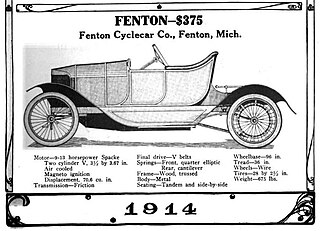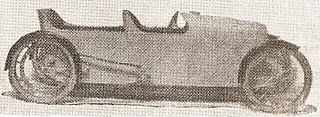
Alldays & Onions was an English engineering business and an early automobile manufacturer based at Great Western Works and Matchless Works, Small Heath, Birmingham. It manufactured cars from 1898 to 1918. The cars were sold under the Alldays & Onions name. Alldays also built an early British built tractor, the Alldays General Purpose Tractor. After the First World War the cars were sold under the name Enfield Alldays. Car production seems to have ceased in the 1920s but the manufacture of many other items continued. The company became part of the Mitchell Cotts Group.

A cyclecar was a type of small, lightweight and inexpensive motorized car manufactured in Europe and the United States between 1910 and the early 1920s. The purpose of cyclecars was to fill a gap in the market between the motorcycle and the car. It could accommodate only two passengers, often sitting in tandem.

The Peerless Motor Car Company was an American automobile manufacturer that produced the Peerless brand of motorcars in Cleveland, Ohio, from 1900 to 1931. One of the "Three Ps" – Packard, Peerless, and Pierce-Arrow – the company was known for building high-quality luxury automobiles. Peerless popularized a number of vehicle innovations that later became standard equipment, including drum brakes and the first enclosed-body production cars.

The Jeffery brand of automobiles were manufactured by the Thomas B. Jeffery Company in Kenosha, Wisconsin.

The Thomas B. Jeffery Company was an American automobile manufacturer in Kenosha, Wisconsin, from 1902 until 1916. The company manufactured the Rambler and Jeffery brand motorcars. It was preceded by the Gormully & Jeffery Manufacturing Company, a bicycle manufacturer. It was the predecessor company to Nash Motors, and thus one of the predecessor companies of American Motors Corporation (AMC) and later Chrysler.

The LuLu cyclecar was produced by the Kearns Motor Truck Company in Beavertown, Snyder County, Pennsylvania from 1914 to 1915.

The Smith Flyer was an American automobile manufactured by the A.O. Smith Company in Milwaukee from 1915 until about 1919 when the manufacturing rights were sold to Briggs & Stratton and it was renamed the Briggs & Stratton Flyer.
The Autoette, also known as the Manistee, was an American automobile manufactured in Manistee, Michigan by the Manistee Motor Car Company from 1910 to 1913. The Autoette was one of the first cyclecars. It had a single cylinder, 5 hp engine that was 0.4 L in size, and a friction transmission. The two-seater roadster cost $300.

The Car-Nation was a brand of automobile manufactured in Detroit, Michigan, by the American Voiturette Company from 1913 to 1914.

The JPL was a brass era cyclecar built in Detroit, Michigan by the J.P.L. Cyclecar Company, formed in 1913. Production started in December 1913 but ended in 1914.

The Koppin was a cyclecar built in Fenton, Michigan, by the Koppin Motor Company in 1914.

The Mercury was a cyclecar built in Detroit, Michigan, by the Mercury Cyclecar Company at 807 South Scotten Street in 1913-1914.

Scripps-Booth was a United States automobile marque based in Detroit, Michigan. Established by James Scripps Booth in 1913, Scripps-Booth Company produced motor vehicles and was later acquired by General Motors, becoming a division of it, until the brand was discontinued in 1923.

The Austro was an Austrian automobile manufactured from 1913 to 1914. It was one of few cyclecars produced in Central Europe. Powered by a 6 horsepower NSU engine, it had a 4-speed gearbox and double chain final drive. It had an independent front suspension, using sliding pillars on the lines of the Morgan. Austro cyclecars did well in mountain trials, as well as the Semmering Hill Climbs. Austro also manufactured aeroplanes.

The Partin Manufacturing Company was a brass era American automobile manufacturer, headquartered at 29 South LaSalle Street, Chicago, Illinois from 1913 to 1917. The Partin-Palmer automobile and Pioneer cyclecar were produced.

The Cunningham Car Company was a pioneering American production automobile manufacturer. Theirs was one of the earliest vehicles of the automotive age. Cunninghams were produced from 1896 to 1931 in Rochester, New York by James Cunningham, Son and Company who had been in the carriage manufacturing business since 1836.

The W. H. Kiblinger Company and the W. H. McIntyre Company produced Brass Era automobiles in Auburn, Indiana from 1907 to 1915.

The Signet cyclecar was the name used by Fenton Engineering Company of Fenton, Michigan from 1913 to 1914. In 1914 the name was changed to Fenton and was manufactured by the Fenton Cyclecar Company. In May 1914, The Fenton became the Koppin and was produced by the Koppin Motor Company until September 1914.
The States was a cyclecar manufactured by the States Cyclecar Company of Detroit, Michigan in 1915.

















